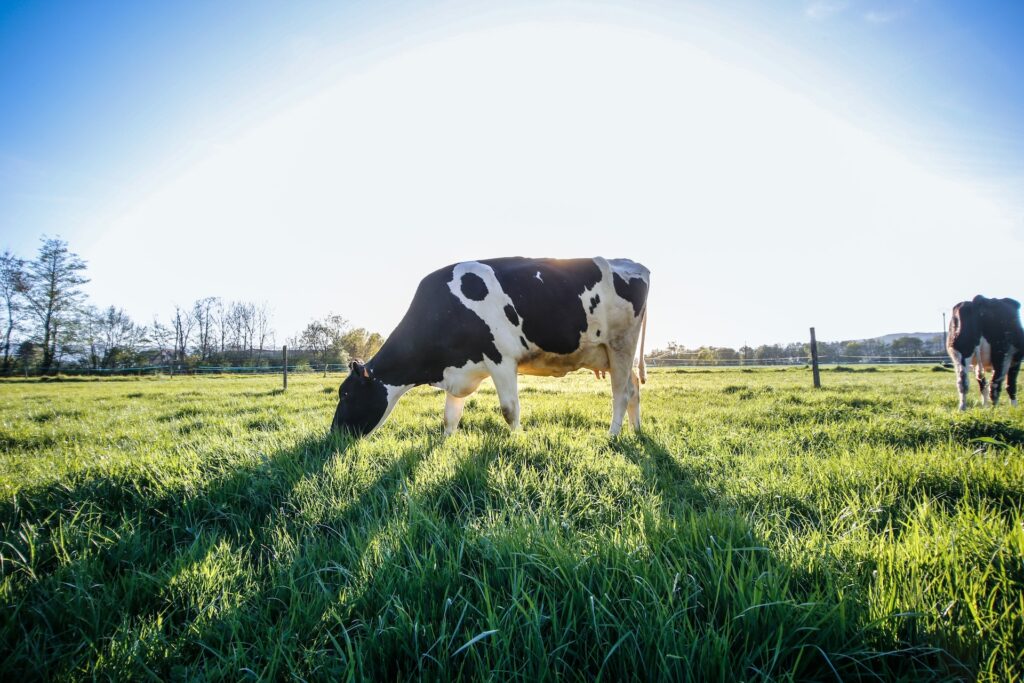We hear or see it enough now sitting at the restaurant and knowing there’s a grass-fed beef option, but you ask… What’s so special about grass-fed? Is it really healthier for me? What are the real differences?
Well, is it really healthier for me? There hasn’t been any study done that can definitively tell us the answer to that question. The study that could would just be plainly infeasible to conduct. But, what I can discuss are aspects of the differences between how the two feed strategies affect the cows through the entire process to perhaps make an inference as to what frame of mind we should have regarding beef.
The first thing to consider is the cow’s biomechanics.

Cows’ stomachs are designed specifically to process grass. Not grain or corn. The takeaway here is that in the feedlots, cows are fed massive amounts of grain and corn so that they pack on weight at an insurmountable speed. So much so, that when it would have taken a grass-fed cow 10-12 years to be big enough for slaughter, grain-fed ones are ready within a year. But, given so much of this feed that the cow’s stomach is not designed for causes some issues with the cow’s health. The pH of their stomaches is usually basic when digesting grass, when fed grain it becomes acidic. The microbes that cause concerning infections prefer that acidic environment and thrive when given grain feed. Now, antibiotics have to be given in advance to prevent infections. Cows eventually develop infections in their livers due to ulcerations in the stomach from the acidity allowing for microbes to travel along. They get into terrible shape and we have to keep giving antibiotics just to deal with the infections. What’s worse is, sometimes the farmers don’t even care about the liver because that’s not even a part most people would even eat. So, they ignore the liver abscesses that form, because it’s financially viable for them.
The second factor to consider is that these cows in feedlots live on and in piles of their own feces. The ammonia that builds up irritates their skin, not to mention all the microbes that reside in the manure. It’s a petri dish of enormous proportions. So the animals are incredibly prone to infections in this sort of environment, further necessitating the use of antibiotics. With the rise of antibiotic resistance, the industry has turned to using irradiation to combat microbial infection.
It’s even been demonstrated that by getting the cattle back on a diet of grass and hay, their conditions improve. But by doing so, they lose weight and don’t grow as fast. So as the farmers would lose money on such a plan they tend to decline to make that adjustment.
The third factor is the omega fatty acid profile. Where most are concerned about the ratio, the sheer amount is the true concern.
Eating the SAD(Standard American Diet), one consumes up and above the normal levels of omega-6s, whereas eating meats one consumes relatively negligible amounts of omega-6s irrespective of the omega-3:omega-6 ratio. At the end of the day, eliminating processed foods from the diet will already improve your omega-3:omega-6 balance. But this is just an optimization as these differences are minor in scale.
In addition to the omega profile, there is the vitamin profile.
While there is a measurable difference in nutritional content between grass and grain-finished beef, there is little if any evidence that can definitively demonstrate that there is a meaningful impact on health when eating between the two types of meat.
The important thing is that we eat more meats in general. Doing that alone would significantly improve our health status regardless of the meat being grass or grain-fed. The distinction between the two is again, an optimization one could make after making the switch to more meats in the diet.
TL;DR
Grass-fed beef overall has better impacts for the environment, animal welfare, and nutritional profile of the meat itself, however the most pressing issue remains eating more meats generally for improved health.
Other resources:
Does Grass Fed Beef Make a Difference? – Omega 3 vs 6 Fats
Vitamin A with Dr. Mike Bucknell
Health Benefits of Grass-Fed Products
Is Grass Fed Beef Better Than Grain Fed? A Discussion with Robb Wolf
Grass-Fed or Grain-Finished: Peter Ballerstedt
Grass Fed Beef – Everything You Need To Know And Where To Buy It
Is 100% Grass-fed milk different than Pasture Raised milk? | Ask Organic Valley
Grass Fed Beef vs Grain Fed Beef (What’s the Difference) | The Bearded Butchers
Papers:
